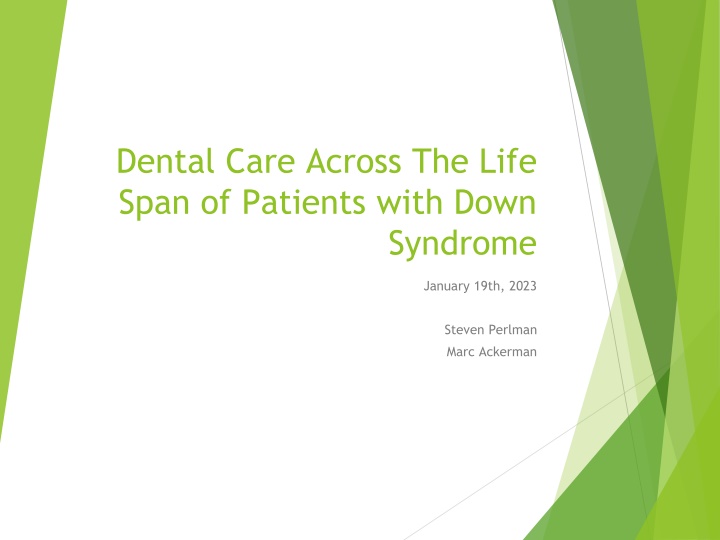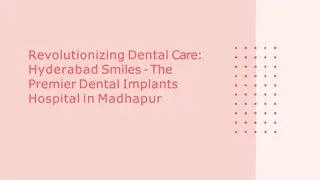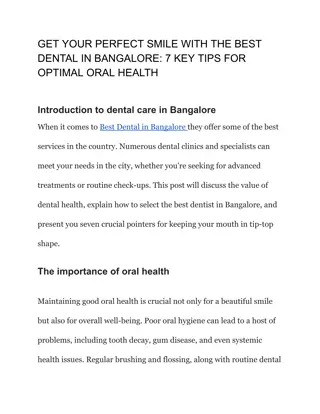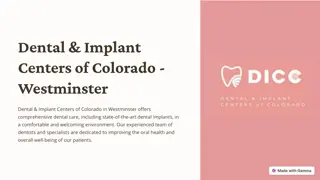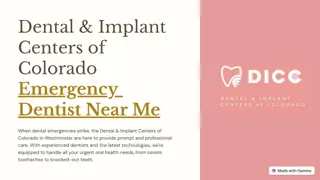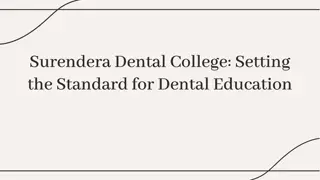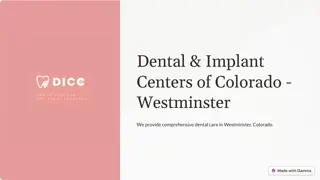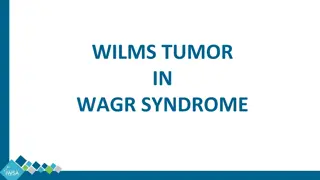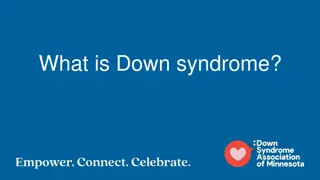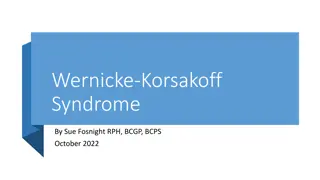Challenges in Dental Care for Patients with Down Syndrome
This presentation highlights various barriers to dental care faced by individuals with Down Syndrome, including dependence on others, financial constraints, and the stigma associated with this population. Communication difficulties, turnover of support professionals, and challenges in follow-up care also contribute to the complexities in providing comprehensive dental services for these patients.
Download Presentation

Please find below an Image/Link to download the presentation.
The content on the website is provided AS IS for your information and personal use only. It may not be sold, licensed, or shared on other websites without obtaining consent from the author.If you encounter any issues during the download, it is possible that the publisher has removed the file from their server.
You are allowed to download the files provided on this website for personal or commercial use, subject to the condition that they are used lawfully. All files are the property of their respective owners.
The content on the website is provided AS IS for your information and personal use only. It may not be sold, licensed, or shared on other websites without obtaining consent from the author.
E N D
Presentation Transcript
Dental Care Across The Life Span of Patients with Down Syndrome January 19th, 2023 Steven Perlman Marc Ackerman
BARRIERS TO CARE Degree of Dependence on Others Finances Attitudes of Care Provider Availability of Professional Care Handicap Access
STIGMA Described by Goffman as spoiled identify stigma impacts on health care by having providers not see this population as benefiting from preventive protocols, receiving adequate pain medication, surveillance for risk factors associated by many health care professionals as a low reward population, limited respect afforded to those clinicians with an allegiance to this population.
COMMUNICATION Difficult for clinicians to understand patients with limited expressive communication, limited time by physicians and dentists increases the frustration and they do not take thorough histories leading to premature, ill thought thru treatment plans. Difficult for clinicians to know who is in charge (who has the legal authority to represent the patient).
DIRECT SUPPORT PROFESSIONALS (DSP) DSPs or front line staff: At best the DSP s are dedicated, committed supporters-unfortunately (based on statistics) there is a high turnover (70%+) which contributes to lack of continuity of care, indifference, low health literacy, limited experience, limited person specific care skills, no career ladder, low pay and limited societal appreciation of their role.
FOLLOW UP Follow up (return to clinic or specialty referrals) is often derailed by staff changes, inability to transport to office because of strict staff-client ratios (and inability to free up a staff person to escort patients to office). Lack of proper record keeping (bowel movement logs, seizure logs, temperature logs, behavioral records, medication compliance) negates value of follow up. Often staff do not comply with instructions (no food after midnight, bring all current medications, food lists) thus negating the yield of the appointment.
COMMUNITY CONTINUITY OF CARE Reimbursement changes effect the scheduling, frequency and intervals of needed therapies (OT, SLP, PT, sensory support, behavioral interventions). Staff changes, regulatory mandates, lack of care transition plans. Lack of transition from pediatric to adult world Transition from family to group home
SOCIAL ROLE VALORIZATION Coined by Wolf Wolfensberger; described the low view that society holds for people with intellectual and developmental disabilities. Describes how society views them as burdens, menaces, uneducable, non- contributory, pitiful, holy innocents values that provide little incentive to support their development including their health care status.
HEALTH BELIEF SYSTEMS What exactly is the value of health and wellness to individuals that require constant and intense care regardless of their health status. Inappropriate belief that all presenting problems relate to the individual s primary disabling condition.
CULTURE Every agency, medical and dental office, clinic and health care community has their own distinct and unique culture. The culture often determines the core values of the group and dictates the level of care from suboptimal to stellar. Cultural values dictate the level of care, depth of follow up, insistence of collaboration and referral and need to go the distance. Erroneous mythology about health, nature and characteristics of individuals with intellectual and developmental disabilities.
REGULATIONS Local, state and federal regulations often impede best health care practices, for example, in some states there is a policy that restricts the application of sun block to licensed nurses; direct support professionals are not permitted to use this to prevent sunburn and sun poisoning. Many regulations are dinosaural, archaic, and no longer making sense in community support infrastructure.
ACCOUNTABILITY Many layers of management community support agencies, multi disciplinary staff, silo mentality, fear of scope of practice violations. echo of not my responsibility.
OWNERSHIP Who actually is the responsible party? Problems with balancing competency, self determination, assignment of legal custodians and guardians, informed consent, medical legal issues.
CHANGING THE FACE OF HEALTH CARE Increase of new physicians and dentists opting out of private practice to become employees of HMOs, hospitals, clinics, large consolidated groups and have limited input as to patient populations, formulary choices, protocols, and advocacy. Use of hospitalists dilute the continuity of care.
ORAL HEALTH Number one unmet healthcare need in individuals with IDND Periodontal disease - higher rate of gingivitis and periodontal disease than the population Dental caries - develop caries at the same rate as the general population but prevalence of untreated dental caries is higher Malocclusion, missing permanent teeth, delayed eruption, and enamel hypoplasia are more common Damaging oral habits may be present (bruxism, mouth breathing, tongue thrust, self injurious behavior and pica Increased risk for oral trauma and injury general
BEHAVIORAL Behavioral phenotypes and genotypes Behavior is always a "communication" expression Aggression, self injurious, impulse control Inability to express pain is often causative
Picture 2 Unmet Dental Care Needs Among Children With Special Health Care Needs: Implications for the Medical Home Charlotte Lewis, Andrea S. Robertson and Suzanne Phelps Pediatrics 2005;116;e426-e431 DOI: 10.1542/peds.2005-0390 This information is current as of September 19, 2005 The online version of this article, along with updated information and services is located on the World Wide Web at: http://www.pediatrics.org/cgi/content/full/116/3/e426
Interviewed 38,866 Families CSHCN Results: Dental care is the most prevalent unmet health care need for CSHCN. u Over 78% of CSHCN needed dental care in the past 12 months. u Second only to prescription medications in frequency of need. u Poorer children, uninsured children, children with lapses in insurance, and children with greater disabilities had greater odds of unmet dental needs. u Children with a personal doctor or nurse were significantly less likely to have unmet dental needs. u
Hypokinesis has been identified as an independent risk factor for the origin and progression of several widespread chronic diseases Coronary Heart Disease Diabetes Obesity Metabolic Syndrome Osteoporosis Osteoarthritis Some forms of cancer Depression Low Back Pain High Blood Pressure High Cholesterol
Accelerated Aging phenomenon Individuals with cerebral palsy, spinal cord injuries and other disabilities experience: Greater and earlier loss of musculoskeletal mass and quality u Rapid declines in function u Increased incidence of cardiometabolic musculoskeletal, and psychological morbidity u Decreased disease free survival u
THE FATAL FIVE The Fatal Five refers to the top five disorders linked to preventable deaths of individuals in congregate care settings or in community based residential settings. While the issues can differ in order of frequency depending on the population being represented, the five conditions most likely to result in death or health deterioration for persons with Intellectual and Developmental disabilities are: Bowel Obstruction u GERD u Aspiration u Dehydration u Seizures u
Dental Care Considerations for Patients with Down Syndrome
Introduction Down Syndrome, also known as Trisomy 21, is the most common cause of intellectual disability. The condition is caused by an extra chromosome 21. Down syndrome is connected to a number of medical conditions and physical characteristics, including intellectual disability, characteristic facial features, hand anomalies, and congenital heart defects. About 400,000 Americans are living with Down Syndrome. With advances in medicine, people with Down Syndrome are living longer, on average to 60 years old. Thus, the chances of encountering a patient with Down Syndrome while practicing dentistry are high. Dental providers, regardless of specialty, should be equipped with the skill set and confidence to treat the needs of these patients. u u u u
Oral Manifestations I. Craniofacial Anomalies Maxilla: Small maxilla and midface create prognathism and an Angle s Class III occlusal relationship. u Palate: High arched palate and increased incidence of clefts, may exhibit increased tonsillar tissue causing increased mouth breathing and sleep apnea. u Tongue: Relative macroglossia is caused b a small oral cavity. u Lips: Open bite posture caused by hypotonia causes lip protrusion and drooling, leading to cracks and angular chelitis. u Atlanto-axial instability: Articulation between first and second cervical vertebrae (atlantoaxial joint) may be more mobile in this population, leading to possible neurological signs and warranting special care to this joint when treating a patient. u
Oral Manifestations II. Dental Anomalies Microdontia/abnormal morphology: Small bulbous or conical molars and shovel shaped incisors with small and conical roots are common. u Hypodontia: Lateral incisors, mandibular second premolars, and third molars are commonly missing. u Impaction: Greater incidence of impacted teeth. u Taurodontism: Elongated tooth body and pulp chambers, which may lead to increased restorative needs. u Delayed eruption: Tooth eruption of primary and permanent dentition often follows an abnormal order with completion of primary dentition around the age of 4-5. u Enamel hypoplasia: Infections and fevers can lead to enamel hypoplasia or hypocalcification. u
Oral Health Considerations I. Periodontitis Periodontal disease is the most common oral health problem in patients with Down Syndrome. Patients under 6 years of age may experience mild symptoms, which progress rapidly with age. Periodontal disease often leads tooth mobility, which may precede loss of permanent teeth. While extractions may be indicated in these patients, the tooth mobility itself does not necessitate extractions. Causes of periodontal disease include 1) compromised immune system, 2) malocclusion, 3) bruxism, 4) small tooth roots, 5) poor oral hygiene. The periodontal disease may also be idiopathic. u Recommendations: Chlorhexidine rinse, at home oral hygiene, frequent professional cleanings
Oral Health Considerations III. Infections Patients with Down Syndrome often have compromised immune systems. Thus, the likelihood of dental infections is higher. Patients are commonly diagnosed with Candida infections, aphthous ulcers, and acute necrotizing ulcerative gingivitis. Recommendations: treat infections aggressively, at home oral hygiene, regular dental screenings IV. Premedication Mitral valve prolapse and other valve dysfunctions are common in people with Down Syndrome. Some conditions may put patients at risk of infective endocarditis with dental procedures. u Recommendations: Antibiotic prophylaxis if valves have been repaired with prosthetic material or if patient has a history of infective endocarditis
MEDICALIZATION the tendency to conceive an activity, phenomenon, behavior, condition, etc., as a disease or disorder or as an affliction that should be regarded as a disease or disorder
ASSUMPTION universal standard of dentofacial normality and in particular one ideal constellation of dental traits naturally occurring in humans, which is correlated with superior oral health, function, and appearance
Further Medical Considerations I. Cardiac disorders Considerable cardiac pathology is present, especially in older patients with Down Syndrome. u Mitral Valve prolapse occurs in more than half of patients with Down Syndrome. Valvular dysfunctions in these patients often lead to congestive heart failure. u Recommendations: Cardiology evaluations are recommended for this population undergoing general anesthesia
Further Medical Considerations II. Immune system Patients with Down Syndrome have compromised immune systems, which lead to more frequent systemic and oral infections Recommendations: Antibiotics may be used more frequently, but a conservative approach must be made when prescribing antibiotics to this population so as to avoid overuse III. Sleep Apnea Sleep disordered breathing occurs in at least 50-80% of children with Down Syndrome. u Recommendations: Dental professionals are in unique positions to screen and treat sleep-disordered breathing, thus they must recognize the maxillofacial and pharyngeal features of the disease and inquire about the patient s history of snoring and daytime somnolence
Further Medical Considerations IV. Intellectual disability Patients may have mild to moderate intellectual disability, limiting their abilities to communicate, adapt, and learn. Language development may be impaired or delayed. Recommendations: Listen well, show patient whether you understand. Use simple instructions and repeat them often V. Seizures Infants with Down Syndrome can have seizures. These seizures are usually controllable with anticonvulsant medications. u Recommendations: Advise patients to bring anticonvulsant medications to appointments
Further Medical Considerations VI. Hypotonia Various areas of the body are affected by hypotonia, including large skeletal muscles as well as the mouth. Open bites can form and problems chewing, swallowing, and speaking can also result. VII. Hearing loss and deafness Also common in this population and can negatively impact communication skills VIII. Visual impairments Strabismus, glaucoma, and cataracts can affect those with Down Syndrome. u
II. Anesthesia Behavior, communication, airway obstruction, sleep apnea,bradycardia, gastroesophageal reflux, atanto axial instability, and airway size all affect anesthesia safety. Intubation may be complicated by macroglossia, a small oral opening, a high arched palate, and Angle s Class III occlusion in Down Syndrome patients. It is important to do an in-depth review of developmental and medical issues, allergies , medications, medical and surgical history, and preoperative physical evaluation of patients with Down Syndrome before anesthesia is performed. Recommendations: Complex and lengthy procedures, or treatment on a patient with poor behavior, may need to be carried out under general anesthesia in the hospital setting. In office sedation generally has too many associated risks. III. Abuse Physical and sexual abuse happens in this population. Signs of abuse, including oral signs, should be recognized, reported, and noted. u
Down Syndrome and Sleep-Disordered Breathing Sleep-disordered breathing occurs in at least 50-80% of children with Down Syndrome. Episodic obstruction of the upper airway during sleep, resulting in hypoxemia and frequent arousals, it is associated with symptoms such as snoring and daytime hypersomnolence. Gold standard for treatment is CPAP (Continuous Positive Airway Pressure) breathing. Importance of diagnostic testing and physician collaboration. Waldman, H.B., Hasan, F.M., Perlman, S.P. Down Syndrome and Sleep-Disordered Breathing the Dentist s Role JADA. V. 140, March 2009
